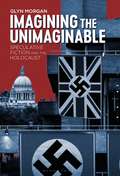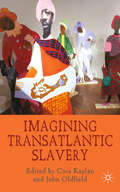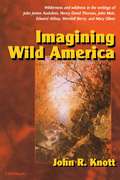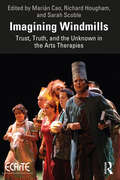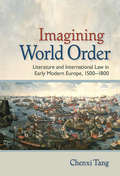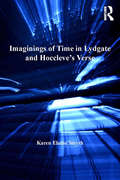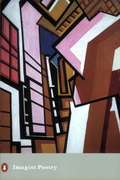- Table View
- List View
Imagining the Soul in Premodern Literature (Early Modern Literature in History)
by Abe DaviesThis book is a study of ghostly matters - of the soul - in literature spanning the tenth century and the age of Shakespeare. All people, according to John Donne, ‘constantly beleeve’ that they have an immortal soul. But he also reflects that in fact there is nothing ‘so well established as constrains us to beleeve, both that the soul is immortall, and that every particular man hath such a soul’. In understanding the question of man's disembodied part as at once fundamental and fundamentally uncertain he was entirely of his time, and Imagining the Soul in Premodern Literature considers this fraught, shifting, yet uniquely compelling entity in the context of the literary forms and effects involved in its representation. Gruesome medieval dialogues between damned souls and worm-eaten bodies; verse and prose works by Donne, René Descartes, Margaret Cavendish and Andrew Marvell; a profusion of sonnet sequences, sermons, manuals of instruction and travelogues; Hamlet and its natural philosophical thinking about the apparently disembodied soul haunting Elsinore: these chapters range across all this and more, offering a rigorous yet accessible account of an essential aspect of premodern literature that will be of interest to scholars, students and the general reader alike.
Imagining the Unimaginable: Speculative Fiction and the Holocaust
by Glyn MorganImagining the Unimaginable examines popular fiction's treatment of the Holocaust in the dystopian and alternate history genres of speculative fiction, analyzing the effectiveness of the genre's major works as a lens through which to view the most prominent historical trauma of the 20th century. It surveys a range of British and American authors, from science fiction pulp to Pulitzer Prize winners, building on scholarship across disciplines, including Holocaust studies, trauma studies, and science fiction studies.The conventional discourse around the Holocaust is one of the unapproachable, unknowable, and the unimaginable. The Holocaust has been compared to an earthquake, another planet, another universe, a void. It has been said to be beyond language, or else have its own incomprehensible language, beyond art, and beyond thought.The 'othering' of the event has spurred the phenomenon of non-realist Holocaust literature, engaging with speculative fiction and its history of the uncanny, the grotesque, and the inhuman. This book examines the most common forms of nonmimetic Holocaust fiction, the dystopia and the alternate history, while firmly positioning these forms within a broader pattern of non-realist engagements with the Holocaust.
Imagining the Unimaginable: Speculative Fiction and the Holocaust
by Glyn MorganImagining the Unimaginable examines popular fiction's treatment of the Holocaust in the dystopian and alternate history genres of speculative fiction, analyzing the effectiveness of the genre's major works as a lens through which to view the most prominent historical trauma of the 20th century. It surveys a range of British and American authors, from science fiction pulp to Pulitzer Prize winners, building on scholarship across disciplines, including Holocaust studies, trauma studies, and science fiction studies.The conventional discourse around the Holocaust is one of the unapproachable, unknowable, and the unimaginable. The Holocaust has been compared to an earthquake, another planet, another universe, a void. It has been said to be beyond language, or else have its own incomprehensible language, beyond art, and beyond thought.The 'othering' of the event has spurred the phenomenon of non-realist Holocaust literature, engaging with speculative fiction and its history of the uncanny, the grotesque, and the inhuman. This book examines the most common forms of nonmimetic Holocaust fiction, the dystopia and the alternate history, while firmly positioning these forms within a broader pattern of non-realist engagements with the Holocaust.
Imagining the Woman Reader in the Age of Dante
by Elena LombardiImagining the Woman Reader in the Age of Dante brings to light a new character in medieval literature: that of the woman reader and interlocutor. It does so by establishing a dialogue between literary studies, gender studies, the history of literacy, and the material culture of the book in medieval times. From Guittone d'Arezzo's piercing critic, the 'villainous woman', to the mysterious Lady who bids Guido Cavalcanti to write his grand philosophical song, to Dante's female co-editors in the Vita Nova and his great characters of female readers, such as Francesca and Beatrice in the Comedy, all the way to Boccaccio's overtly female audience, this particular interlocutor appears to be central to the construct of textuality and the construction of literary authority. This volume explores the figure of the woman reader by contextualizing her within the history of female literacy, the material culture of the book, and the ways in which writers and poets of earlier traditions imagined her. It argues that these figures are not mere veneers between a male author and a 'real' male readership, but that, although fictional, they bring several advantages to their vernacular authors, such as orality, the mother tongue, the recollection of the delights of early education, literality, freedom in interpretation, absence of teleology, the beauties of ornamentation and amplification, a reduced preoccupation with the fixity of the text, the pleasure of making mistakes, dialogue with the other, the extension of desire, original simplicity, and new and more flexible forms of authority.
Imagining the Woman Reader in the Age of Dante
by Elena LombardiImagining the Woman Reader in the Age of Dante brings to light a new character in medieval literature: that of the woman reader and interlocutor. It does so by establishing a dialogue between literary studies, gender studies, the history of literacy, and the material culture of the book in medieval times. From Guittone d'Arezzo's piercing critic, the 'villainous woman', to the mysterious Lady who bids Guido Cavalcanti to write his grand philosophical song, to Dante's female co-editors in the Vita Nova and his great characters of female readers, such as Francesca and Beatrice in the Comedy, all the way to Boccaccio's overtly female audience, this particular interlocutor appears to be central to the construct of textuality and the construction of literary authority. This volume explores the figure of the woman reader by contextualizing her within the history of female literacy, the material culture of the book, and the ways in which writers and poets of earlier traditions imagined her. It argues that these figures are not mere veneers between a male author and a 'real' male readership, but that, although fictional, they bring several advantages to their vernacular authors, such as orality, the mother tongue, the recollection of the delights of early education, literality, freedom in interpretation, absence of teleology, the beauties of ornamentation and amplification, a reduced preoccupation with the fixity of the text, the pleasure of making mistakes, dialogue with the other, the extension of desire, original simplicity, and new and more flexible forms of authority.
Imagining Time in the English Chronicle Play: Historical Futures, 1590-1660
by Marissa NicosiaImagining Time in the English Chronicle Play: Historical Futures, 1590-1660 argues that dramatic narratives about monarchy and succession codified speculative futures in the early modern English cultural imaginary. This book considers chronicle plays—plays written for the public stage and play pamphlets composed when the playhouses were closed during the civil wars—in order to examine the formal and material ways that playwrights imagined futures in dramatic works that were purportedly about the past. Through close readings of William Shakespeare's 1&2 Henry IV, Richard III, Shakespeare's and John Fletcher's All is True, Samuel Rowley's When You See Me, You Know Me, John Ford's Perkin Warbeck, and the anonymous play pamphlets The Leveller's Levelled, 1 & 2 Craftie Cromwell, Charles I, and Cromwell's Conspiracy, the volume shows that imaginative treatments of history in plays that are usually associated with the past also had purchase on the future. While plays about the nation's past retell history, these plays are not restricted by their subject matter to merely document what happened: Playwrights projected possible futures in their accounts of verifiable historical events.
Imagining Time in the English Chronicle Play: Historical Futures, 1590-1660
by Marissa NicosiaImagining Time in the English Chronicle Play: Historical Futures, 1590-1660 argues that dramatic narratives about monarchy and succession codified speculative futures in the early modern English cultural imaginary. This book considers chronicle plays—plays written for the public stage and play pamphlets composed when the playhouses were closed during the civil wars—in order to examine the formal and material ways that playwrights imagined futures in dramatic works that were purportedly about the past. Through close readings of William Shakespeare's 1&2 Henry IV, Richard III, Shakespeare's and John Fletcher's All is True, Samuel Rowley's When You See Me, You Know Me, John Ford's Perkin Warbeck, and the anonymous play pamphlets The Leveller's Levelled, 1 & 2 Craftie Cromwell, Charles I, and Cromwell's Conspiracy, the volume shows that imaginative treatments of history in plays that are usually associated with the past also had purchase on the future. While plays about the nation's past retell history, these plays are not restricted by their subject matter to merely document what happened: Playwrights projected possible futures in their accounts of verifiable historical events.
Imagining Transatlantic Slavery
by C. Kaplan J. OldfieldThis exciting interdisciplinary volume, featuring contributions from a group of leading international scholars, reflects on the long history of representations of transatlantic slaves and slavery, encompassing a broad chronological range, from the eighteenth century to the present day.
Imagining Virginia Woolf: An Experiment in Critical Biography
by Maria DibattistaWhere other works of literary criticism are absorbed with the question--How to read a book?--Imagining Virginia Woolf asks a slightly different but more intriguing one: how does one read an author? Maria DiBattista answers this by undertaking an experiment in critical biography. The subject of this work is not Virginia Woolf, the person who wrote the novels, criticism, letters, and famous diary, but a different being altogether, someone or something Maria DiBattista identifies as "the figment of the author." This is the Virginia Woolf who lives intermittently in the pages of her writings and in the imagination of her readers. Drawing on Woolf's own extensive remarks on the pleasures and perils of reading, DiBattista argues that reading Woolf, in fact reading any author, involves an encounter with this imaginative figment, whose distinct, stylistic traits combine to produce that beguiling phantom--the literary personality. DiBattista reveals a writer who possessed not a single personality, but a cluster of distinct, yet complementary identities: the Sibyl of Bloomsbury, the Author, the Critic, the World Writer, and the Adventurer, the last of which, DiBattista claims, unites them all. Imagining Virginia Woolf provides an original way of reading, one that captures with variety and subtlety the personality that exists only in Woolf's works and in the minds of her readers.
Imagining Virginia Woolf: An Experiment in Critical Biography
by Maria DiBattistaWhere other works of literary criticism are absorbed with the question--How to read a book?--Imagining Virginia Woolf asks a slightly different but more intriguing one: how does one read an author? Maria DiBattista answers this by undertaking an experiment in critical biography. The subject of this work is not Virginia Woolf, the person who wrote the novels, criticism, letters, and famous diary, but a different being altogether, someone or something Maria DiBattista identifies as "the figment of the author." This is the Virginia Woolf who lives intermittently in the pages of her writings and in the imagination of her readers. Drawing on Woolf's own extensive remarks on the pleasures and perils of reading, DiBattista argues that reading Woolf, in fact reading any author, involves an encounter with this imaginative figment, whose distinct, stylistic traits combine to produce that beguiling phantom--the literary personality. DiBattista reveals a writer who possessed not a single personality, but a cluster of distinct, yet complementary identities: the Sibyl of Bloomsbury, the Author, the Critic, the World Writer, and the Adventurer, the last of which, DiBattista claims, unites them all. Imagining Virginia Woolf provides an original way of reading, one that captures with variety and subtlety the personality that exists only in Woolf's works and in the minds of her readers.
Imagining War and Peace in Eighteenth-Century Britain, 1690–1820
by null Andrew LincolnRanging over political, moral, religious, artistic and literary developments in eighteenth-century Britain, Andrew Lincoln explains in a clear and engaging style how the 'civilizing process' and the rise of humanitarianism, far from inhibiting war, helped to make it acceptable to a modern commercial society. In a close examination of a wide variety of illuminating examples, he shows how criticism of the terrible effects of war could be used to promote the nation's war-making. His study explores how ideas and methods were developed to provide the British public with moral insulation from the overseas violence they read about, and from the dire effects of war they encountered at home. It shows, too, how the first campaigning peace society, while promoting pacificism, drew inspiration from the prospects opened by imperial conquest. This volume is an important and timely call to rethink how we understand the cultural and moral foundations of imperial Britain.
Imagining Wild America
by John R. KnottAt a time when the idea of wilderness is being challenged by both politicians and intellectuals, Imagining Wild America examines writing about wilderness and wildness and makes a case for its continuing value. The book focuses on works by John James Audubon, Henry David Thoreau, John Muir, Edward Abbey, Wendell Berry, and Mary Oliver, as each writer illustrates different stages and dimensions of the American fascination with wild nature. John Knott traces the emergence of a visionary tradition that embraces values consciously understood to be ahistorical, showing that these writers, while recognizing the claims of history and the interdependence of nature and culture, also understand and attempt to represent wild nature as something different, other. A contribution to the growing literature of eco-criticism, the book is a response to and critique of recent arguments about the constructed nature of wilderness. Imagining Wild America demonstrates the richness and continuing importance of the idea of wilderness, and its attraction for American writers. John R. Knott is Professor of English, University of Michigan. His previous books include The Huron River: Voices from the Watershed, coedited with Keith Taylor.
Imagining Windmills: Trust, Truth, and the Unknown in the Arts Therapies
by Marián Cao Richard Hougham Sarah ScobleImagining Windmills presents a compilation of scholarly chapters by selected authors of global standing in the arts therapies. This book reflects the theme of the 15th International Conference of the European Consortium for Arts Therapies (ECArTE), held in Alcalá de Henares, Spain, birthplace of Miguel de Cervantes. This innovative work seeks to further understanding of arts therapy education, practice and research and incorporates current thinking from art therapists, dance-movement therapists, dramatherapists and music therapists. Writers from Belgium, Germany, Greece, India, Israel, Italy, The Netherlands, Spain, Sweden, UK and USA combine to give an international voice to the book, which celebrates cultural distinctiveness, while also presenting shared intercultural developments in the professions. This interdisciplinary publication explores questions of the unknown and the imagined, misconception, delusion, truth and trust in the arts therapies. It enquires into ways in which education and the practice of the arts therapies engage with the imagination as a place of multiple realities, which may lead us closer to finding our truth. This book will be of interest and relevance not only to those in the arts therapeutic community, but also to a broad audience including those in related professions – for instance psychology, sociology, the arts, medicine, health and wellbeing and education.
Imagining Windmills: Trust, Truth, and the Unknown in the Arts Therapies
by Marián López Fdz Cao Richard Hougham Sarah ScobleImagining Windmills presents a compilation of scholarly chapters by selected authors of global standing in the arts therapies. This book reflects the theme of the 15th International Conference of the European Consortium for Arts Therapies (ECArTE), held in Alcalá de Henares, Spain, birthplace of Miguel de Cervantes. This innovative work seeks to further understanding of arts therapy education, practice and research and incorporates current thinking from art therapists, dance-movement therapists, dramatherapists and music therapists. Writers from Belgium, Germany, Greece, India, Israel, Italy, The Netherlands, Spain, Sweden, UK and USA combine to give an international voice to the book, which celebrates cultural distinctiveness, while also presenting shared intercultural developments in the professions. This interdisciplinary publication explores questions of the unknown and the imagined, misconception, delusion, truth and trust in the arts therapies. It enquires into ways in which education and the practice of the arts therapies engage with the imagination as a place of multiple realities, which may lead us closer to finding our truth. This book will be of interest and relevance not only to those in the arts therapeutic community, but also to a broad audience including those in related professions – for instance psychology, sociology, the arts, medicine, health and wellbeing and education.
Imagining women readers, 1789–1820: Well-regulated minds
by Richard RitterImagining women readers reassesses the cultural significance of women’s reading in the period 1789–1820. From the turbulent years following the French Revolution to the fiction of Jane Austen, this book charts the rise of a self-regulating reader, who possesses both moral and cultural authority. Rather than an unproductive leisure activity, for the writers discussed in this study the act of reading is crucial to imagining forms of female participation in national life. The book thus offers a unique perspective on the relationship between reading, education and the construction of femininity, shedding new light on the work of some of the most celebrated women writers of the period. It will appeal to students and scholars interested in the history and representation of reading, and in women’s writing of this period more generally.
Imagining women readers, 1789–1820: Well-regulated minds
by Richard RitterImagining women readers reassesses the cultural significance of women’s reading in the period 1789–1820. From the turbulent years following the French Revolution to the fiction of Jane Austen, this book charts the rise of a self-regulating reader, who possesses both moral and cultural authority. Rather than an unproductive leisure activity, for the writers discussed in this study the act of reading is crucial to imagining forms of female participation in national life. The book thus offers a unique perspective on the relationship between reading, education and the construction of femininity, shedding new light on the work of some of the most celebrated women writers of the period. It will appeal to students and scholars interested in the history and representation of reading, and in women’s writing of this period more generally.
Imagining Women's Property in Victorian Fiction
by Jill RappoportImagining Women's Property in Victorian Fiction reframes how we think about Victorian women's changing economic rights and their representation in nineteenth-century novels. The reform of married women's property law between 1856 and 1882 constituted one of the largest economic transformations England had ever seen, as well as one of its most significant challenges to family traditions. By the end of this period, women who had once lost their common-law property rights to their husbands reclaimed their own assets, regained economic agency, and forever altered the legal and theoretical nature of wedlock by doing so. Yet in literary accounts, reforms were neither as decisive as the law implied nor limited to marriage. Legal rights frequently clashed with other family claims, and the reallocation of wealth affected far more than spouses or the marital state. Competition between wives and children is just one of many ways in which Victorian fiction suggests the perceived benefits and threats of property reform. In nineteenth-century fiction, portrayals of women's claims to ownership provide insight into the social networks forged through property transactions and also offer a lens to examine a wide range of other social matters, including testamentary practices, wills, and copyright law; economic and evolutionary models of mutuality; the twin dangers of greed and generosity; inheritance and custody rights; the economic ramifications of loyalty and family obligation; and the legacy of nineteenth-century economic practices for women today. Understanding the reform of married women's property as both an ideologically and materially substantial redistribution of the nation's wealth as well as one complicated by competing cultural traditions, this book explores the widespread ways in which women's financial agency was imagined by fiction that engages with but also diverges from the law in accounts of economic choices and transactions. Repeatedly, narratives by Austen, Dickens, Gaskell, Trollope, Eliot, and Oliphant suggest both that the law is inadequate to account for the way that property enables and disrupts relationships, and that the form of the Victorian novel - in its ability to track intimate and intricate exchanges across generations - is better suited to such tasks.
Imagining Women's Property in Victorian Fiction
by Jill RappoportImagining Women's Property in Victorian Fiction reframes how we think about Victorian women's changing economic rights and their representation in nineteenth-century novels. The reform of married women's property law between 1856 and 1882 constituted one of the largest economic transformations England had ever seen, as well as one of its most significant challenges to family traditions. By the end of this period, women who had once lost their common-law property rights to their husbands reclaimed their own assets, regained economic agency, and forever altered the legal and theoretical nature of wedlock by doing so. Yet in literary accounts, reforms were neither as decisive as the law implied nor limited to marriage. Legal rights frequently clashed with other family claims, and the reallocation of wealth affected far more than spouses or the marital state. Competition between wives and children is just one of many ways in which Victorian fiction suggests the perceived benefits and threats of property reform. In nineteenth-century fiction, portrayals of women's claims to ownership provide insight into the social networks forged through property transactions and also offer a lens to examine a wide range of other social matters, including testamentary practices, wills, and copyright law; economic and evolutionary models of mutuality; the twin dangers of greed and generosity; inheritance and custody rights; the economic ramifications of loyalty and family obligation; and the legacy of nineteenth-century economic practices for women today. Understanding the reform of married women's property as both an ideologically and materially substantial redistribution of the nation's wealth as well as one complicated by competing cultural traditions, this book explores the widespread ways in which women's financial agency was imagined by fiction that engages with but also diverges from the law in accounts of economic choices and transactions. Repeatedly, narratives by Austen, Dickens, Gaskell, Trollope, Eliot, and Oliphant suggest both that the law is inadequate to account for the way that property enables and disrupts relationships, and that the form of the Victorian novel - in its ability to track intimate and intricate exchanges across generations - is better suited to such tasks.
Imagining World Order: Literature and International Law in Early Modern Europe, 1500–1800
by Chenxi TangIn early modern Europe, international law emerged as a means of governing relations between rapidly consolidating sovereign states, purporting to establish a normative order for the perilous international world. However, it was intrinsically fragile and uncertain, for sovereign states had no acknowledged common authority that would create, change, apply, and enforce legal norms. In Imagining World Order, Chenxi Tang shows that international world order was as much a literary as a legal matter. To begin with, the poetic imagination contributed to the making of international law. As the discourse of international law coalesced, literary works from romances and tragedies to novels responded to its unfulfilled ambitions and inexorable failures, occasionally affirming it, often contesting it, always uncovering its problems and rehearsing imaginary solutions.Tang highlights the various modes in which literary texts—some highly canonical (Camões, Shakespeare, Corneille, Lohenstein, and Defoe, among many others), some largely forgotten yet worth rediscovering—engaged with legal thinking in the period from the sixteenth to the eighteenth century. In tracing such engagements, he offers a dual history of international law and European literature. As legal history, the book approaches the development of international law in this period—its so-called classical age—in terms of literary imagination. As literary history, Tang recounts how literature confronted the question of international world order and how, in the process, a set of literary forms common to major European languages (epic, tragedy, romance, novel) evolved.
Imagining Xerxes: Ancient Perspectives on a Persian King (Bloomsbury Studies in Classical Reception #6)
by Emma BridgesXerxes, the Persian king who invaded Greece in 480 BC, quickly earned a notoriety that endured throughout antiquity and beyond. The Greeks' historical encounter with this eastern king – which resulted, against overwhelming odds, in the defeat of the Persian army – has inspired a series of literary responses to Xerxes in which he is variously portrayed as the archetypal destructive and enslaving aggressor, as the epitome of arrogance and impiety, or as a figure synonymous with the exoticism and luxury of the Persian court. Imagining Xerxes is a transhistorical analysis that explores the richness and variety of Xerxes' afterlives within the ancient literary tradition. It examines the earliest representations of the king, in Aeschylus' tragic play Persians and Herodotus' historiographical account of the Persian Wars, before tracing the ways in which the image of Xerxes was revisited and adapted in later Greek and Latin texts. The author also looks beyond the Hellenocentric viewpoint to consider the construction of Xerxes' image in the Persian epigraphic record and the alternative perspectives on the king found in the Jewish written tradition.Analysing these diverse representations of Xerxes, this title explores the reception of a key figure in the ancient world and the reinvention of his image in a remarkable array of cultural and historical contexts.
Imagining Xerxes: Ancient Perspectives on a Persian King (Bloomsbury Studies in Classical Reception #1)
by Emma BridgesXerxes, the Persian king who invaded Greece in 480 BC, quickly earned a notoriety that endured throughout antiquity and beyond. The Greeks' historical encounter with this eastern king – which resulted, against overwhelming odds, in the defeat of the Persian army – has inspired a series of literary responses to Xerxes in which he is variously portrayed as the archetypal destructive and enslaving aggressor, as the epitome of arrogance and impiety, or as a figure synonymous with the exoticism and luxury of the Persian court. Imagining Xerxes is a transhistorical analysis that explores the richness and variety of Xerxes' afterlives within the ancient literary tradition. It examines the earliest representations of the king, in Aeschylus' tragic play Persians and Herodotus' historiographical account of the Persian Wars, before tracing the ways in which the image of Xerxes was revisited and adapted in later Greek and Latin texts. The author also looks beyond the Hellenocentric viewpoint to consider the construction of Xerxes' image in the Persian epigraphic record and the alternative perspectives on the king found in the Jewish written tradition.Analysing these diverse representations of Xerxes, this title explores the reception of a key figure in the ancient world and the reinvention of his image in a remarkable array of cultural and historical contexts.
Imaginings Of Sand
by André BrinkTHE BOOK: A narrative counterpoint between two women, two South Africas. Kristien Muller returns from London to her homeland to fulfil a promise. Her grandmother lies on her deathbed unleashing a turmult of myth, legend and brute fact. Confronted by the realities of a land hurtling towards change, Kristien discovers that the present holds its own moments of savagery. A searing panorama of South Africa's experience, reminiscent in its political & imaginative scope of Marquez's One Hundred Years Of Solitude.
Imaginings of Time in Lydgate and Hoccleve's Verse
by Karen Elaine SmythUsing empirical research to explore medieval writers' imaginings of time, this study presents a new morphology by which to study narratives of time in fifteenth-century literary culture, focusing on poems of John Lydgate and Thomas Hoccleve. Karen Smyth begins with an overview of medieval time-keeping devices and considers collective and individual attitudes and perceptions of time. She then examines a range of Middle English authors' appropriations and innovations in relation to such perceptions, identifying competitions of tradition and innovation, allowing for an interrogation of commonly accepted medieval theories of time. An empirically based morphology emerges and is used to examine narratives of time in Lydgate and Hoccleve's work. Through a series of close readings of selected short poems and Lydgate's Troy Book, Fall of Princes, and Siege of Thebes and of Hoccleve's Regiments of Princes and Series, Karen Smyth looks at expressions of time and examples of the authors' negotiation of time consciousness, illustrating how both poets manipulate a range of cultural narratives of time in order to create multiple and sometimes competing temporalities within a single poem. Smyth simultaneously draws attention to Lydgate's and Hoccleve's underestimated artistic skills and lays out a means to re-evaluate medieval cultural attitudes towards time.
Imaginings of Time in Lydgate and Hoccleve's Verse
by Karen Elaine SmythUsing empirical research to explore medieval writers' imaginings of time, this study presents a new morphology by which to study narratives of time in fifteenth-century literary culture, focusing on poems of John Lydgate and Thomas Hoccleve. Karen Smyth begins with an overview of medieval time-keeping devices and considers collective and individual attitudes and perceptions of time. She then examines a range of Middle English authors' appropriations and innovations in relation to such perceptions, identifying competitions of tradition and innovation, allowing for an interrogation of commonly accepted medieval theories of time. An empirically based morphology emerges and is used to examine narratives of time in Lydgate and Hoccleve's work. Through a series of close readings of selected short poems and Lydgate's Troy Book, Fall of Princes, and Siege of Thebes and of Hoccleve's Regiments of Princes and Series, Karen Smyth looks at expressions of time and examples of the authors' negotiation of time consciousness, illustrating how both poets manipulate a range of cultural narratives of time in order to create multiple and sometimes competing temporalities within a single poem. Smyth simultaneously draws attention to Lydgate's and Hoccleve's underestimated artistic skills and lays out a means to re-evaluate medieval cultural attitudes towards time.
Imagist Poetry (Penguin Modern Classics)
by Peter JonesImagism was a brief, complex yet influential poetic movement of the early 1900s, a time of reaction against late nineteenth-century poetry which Ezra Pound, one of the key imagist poets, described as ‘a doughy mess of third-hand Keats, Wordsworth … half-melted, lumpy’. In contrast, imagist poetry, although riddled with conflicting definitions, was broadly characterized by brevity, precision, purity of texture and concentration of meaning: as Pound stated, it should ‘use no superfluous word, no adjective, which does not reveal something … it does not use images as ornaments. The image itself is the speech’. It was this freshness and directness of approach which means that, as Peter Jones says in his invaluable Introduction, ‘imagistic ideas still lie at the centre of our poetic practice’.

